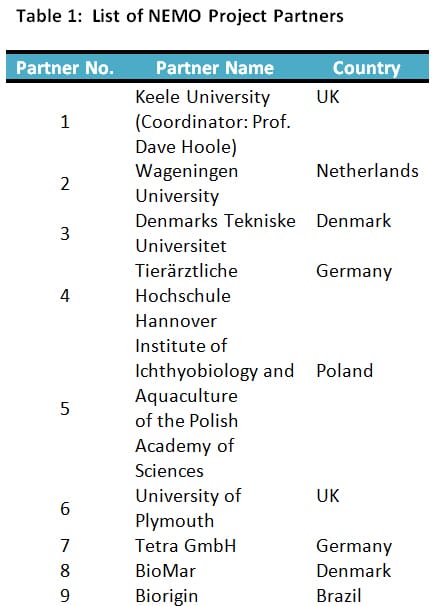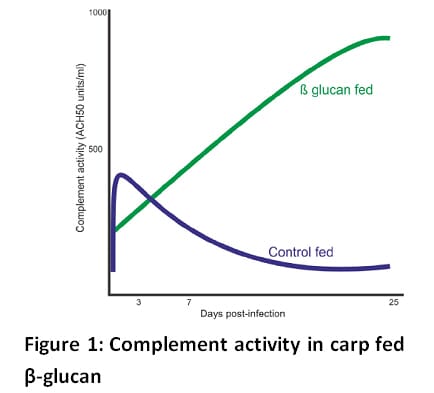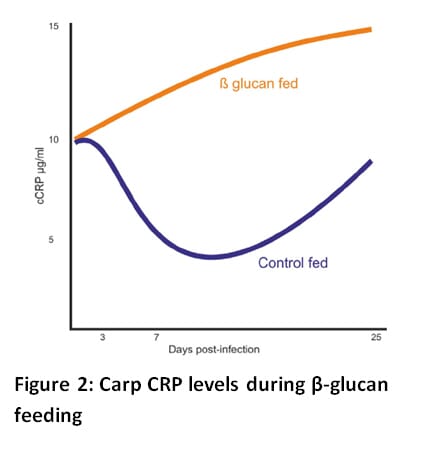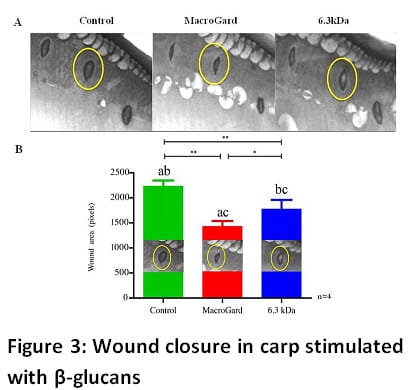Preventing disease is far more efficient and cost effective than treating it; any livestock producer knows this. The question has always been, “How can we do this effectively?”
Chemical and antibiotic use is no longer viewed in the same high regard as they once were due to environmental concerns. This has spurred research into new methods of preventing infection and treating disease. Vaccines have been developed but are limited as a tool because they only target specific defense responses. What is needed is a method to increase an animal’s overall resistance to infection thus improving optimal health using more natural products and processes.
Eating is the essential requirement for all livestock, whether on land or in water. Using food as the delivery system to boost an animal’s health and welfare only makes sense, given the significance of diet formulation and feed production, especially in the expanding aquaculture and ornamental fisheries sectors.
Integrating enhanced growth with improving health using natural diet formulations requires much scientific research.
Enter NEMO, or its more formal name, ‘Training network on protective immune modulation in warm water fish by feeding glucans’. NEMO was a 4-year project (2008-2012) with 9 partners from the research and business sectors (Table 1) whose goal was to investigate various aspects of beta-glucan (β-glucan) activity in fish. The project was awarded by the European Commission and funded under the Marie Curie Initial Training Networks (ITN) programme.

β-glucan, are molecules comprised of simple sugars (long chain carbohydrates) and can be extracted from cereals (e.g., barley, oats), algae, mushrooms and yeast cell walls. Scientists have evaluated them for their anticancer effects as well as their ability to reduce lipid and sugar levels in blood. In fact, β-glucan has been shown to have powerful immunostimulant properties (stimulates the animal immune system) in a range of veterinary disciplines.
β-glucans are currently available in various forms (e.g. MacroGard® by Biorigin) and are mainly produced from yeast species, all of which have been approved for use in domestic animals in the European Union and several countries worldwide. Using β-glucans in aquaculture requires cost-effective delivery systems that do not stress the fish. Realistically, this can only be achieved via feeding.
As a result, NEMO’s scientific aim was to establish best practices for using β-glucans to strategically improve fish health. This entailed formulating β-glucans to assess how they affect the fish’s innate immune response as well as how to maximize the immune stimulating effects in the warm water aquaculture and aquaria sectors.
Research Highlights
NEMO research has shown that 3 weeks of feeding MacroGard® at the commercially recommended dose of 0.1 % (i.e. 10 mg/kg fish per day) had no adverse effects related to fish cell death but did enhance gene expression related to nitric oxide production, a microbiocide that kills disease carrying micro-organisms. (See Figures 1 and 2)


Figures 1 and 2 reveal how the feeding of β-glucan can stimulate the production of important immune proteins such as CRP and Complement which are important in the disease protection of cultured fish.
The bacterium Aeromonas salmonicida and the virus spring viremia of carp virus (SVCV) were found to induce fish cell death, which may help the pathogens to evade the host’s immune system. The koi herpesvirus (KHV) followed a different strategy, evading the host’s immune response by inhibiting cell death and using host cells as safe havens to replicate and spread.
Fish diseases such as the ones indicated above can have an impact on product quality, for example scaring as a result of the tissue regeneration process. Consequently, NEMO examined the ability of β-glucans to promote wound healing in common carp. Researchers measured wound closure after bath treatments with two β-glucans which differed slightly in molecular structure. Furthermore, gene expression profiles of some pro-inflammatory molecules were analysed by quantitative real time polymerase chain reaction (qPCR), a lab technique used to amplify and simultaneously quantify a targeted DNA molecule. Results indicated that both β-glucan treatments improved wound closure and suggested that it could be due to the enhancement of an early inflammatory response involving the prompt decrease of neutrophils, a type of white blood cells, from the wound. β-glucans do not appear to have a direct effect on carp tissue regeneration. Results suggested that an interaction between tissue and immune-cells is needed for β-glucan to enhance wound healing. (See Figure 3)

A) Images of the wound area in carp 14 days post-wounding, from right to left: Control carp, Carp stimulated with MacroGard® bath, and carp stimulated with 6.3kDa β-glucan bath. The yellow circles highlight the central wound of each fish. B) Statistical representation of the wound sizes 14 days post wounding. Bars represent the mean value of wound pixels and error bars show standard deviation, n=4 except by MacroGard® where n=3. *=P<0.05, ***=P<0.01
NEMO examined if beta glucans in feed can improve fish skin or gut health resulting in enhanced protection against invading pathogens. By first characterising several components of the skin mucosal infection barrier in carp, researchers examined the response of these components to pathogen challenge by a virus and a bacterium. Results confirmed that beta glucans have the potential to stabilise the mucosal defence system in carp.
As aquaculture production intensifies, stress on the fish can lead to disease outbreaks. Considerable effort is on-going to find effective protective measures to enhance the immune response of fish reared under intensive conditions. For cyprinids there is some evidence that β-glucans can boost the innate immune response and disease resistance but reported effects on growth performance and intestinal microbial communities are scarce. NEMO showed in feeding experiments that using high dietary inclusion levels of Macrogard® significantly improved growth performance parameters of mirror carp (Cyprinus carpio L.) and significantly elevated the number of pathogen fighting leucocytes in the blood.
Implications for aquaculture
Significantly, what the results show is that using β-glucan can be an alternative low cost strategy to enhance and stimulate the fish immune system, thus reducing the need for antibiotics and vaccines. More about the exciting work carried out by NEMO will form the basis of further articles.
September 2013




